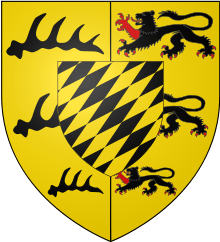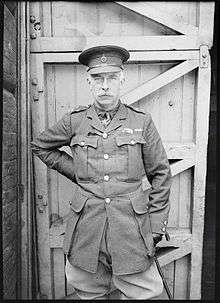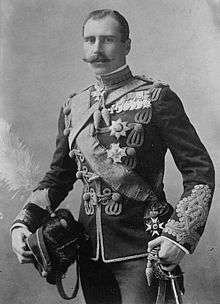Duke of Teck
_Scheibler429ps.jpg)
The Duke of Teck was, in medieval times, a title borne by the head of a branch line of the German ducal House of Zähringen from 1187 to 1439, known historically as the first House of Teck. His territory was centered on Teck Castle in Swabia.
The title was recreated in 1871 in the Kingdom of Württemberg for a cousin of its king, Charles I, whose descendants settled in the United Kingdom and married into the British Royal Family.
The First House of Teck
Adalbert I, son of Duke Conrad I of Zähringen, inherited his father's Swabian possessions around Teck Castle between Kirchheim and Owen. After the death of his brother Duke Berthold IV in 1186, Adalbert adopted the title of "Duke of Teck". His descendant Duke Conrad II upon the death of King Rudolph I of Germany in 1291 even became a candidate for the election as King of the Romans, but probably was slain by his opponent Siegfried of Westerburg, Archbishop of Cologne, the next year.
In the 13th century, the family divided into the lines of Teck-Oberndorf and Teck-Owen. The Dukes of Teck-Oberndorf died out in 1363 and Frederick of Teck-Owen sold their possessions to the Counts of Hohenberg. In 1365, the Dukes of Teck-Owen came into the possession of Mindelheim but had to sell their lands around the castle Teck to the Counts of Württemberg in 1381. The last member of that line, Louis of Teck, Patriarch of Aquileia from 1412, died in 1439.
In 1495 Emperor Maximilian I elevated Count Eberhard von Württemberg to the status of reigning Duke (Herzog) of Würrtemberg, also granting him the defunct title, "Duke of Teck". However, the title was not borne independently by any member or branch of that dynasty.
The Württemberg cadet branch

Duke Alexander of Württemberg (1804-1885), an Austrian major-general and cadet of the dynasty which had become kings of Württemberg in 1805, re-established a non-dynastic line of Dukes of Teck by his 1835 morganatic marriage with the Hungarian countess Countess Claudine Rhédey von Kis-Rhéde (1812-1841). Their son, excluded from succession to the throne of Württemberg, was born Count Francis von Hohenstein (1837-1900), sharing the title his mother was granted by Emperor Ferdinand I of Austria on 16 May 1835, two weeks after the couple married in Vienna.[1]
In 1863, King William I of Württemberg raised Francis in rank to "Prince (Fürst) of Teck" with the style Serene Highness (Durchlaucht), heritable by all his male-line descendants. In 1866 Francis married Princess Mary of Cambridge, a member of the British Royal Family and granddaughter of King George III. As the couple had to live on Mary's Parliamentary annuity, the prince having inherited little income, they lived mostly in England, first at Kensington Palace where their children were born, later at Royal Lodge in Surrey,[1] both residences lent them by Queen Victoria. In 1871, King Charles I of Württemberg granted Francis the new (and, within the German nobility, higher) title "Duke (Herzog) of Teck",[2] heritable by male-line primogeniture. In 1887, Queen Victoria granted the Duke of Teck the British style of His Highness,[1] on a non-hereditary basis.
In 1893, Francis' daughter, Princess Victoria Mary of Teck married Prince George, Duke of York who later reigned as King George V.[2] When the first Duke of Teck died in 1900, the dukedom passed to his eldest son, HSH Prince Adolphus of Teck. King George V granted the second Duke of Teck, his brother-in-law, the personal style of His Highness in 1911.
The title existed until World War I, when anti-German sentiment in the United Kingdom prompted the British monarch to adopt a non-German surname and relinquish all German titles on behalf of himself and those of his family members domiciled in his realms, including the Tecks.[2]
The Duke of Teck thus renounced, in July 1917, his German titles of prince and duke in the Kingdom of Württemberg, as well as the styles of Highness and Serene Highness. Adolphus, along with his brother, Prince Alexander of Teck, then assumed the name "Cambridge", which had been borne as his territorial designation by their maternal grandfather, Prince Adolphus, Duke of Cambridge. This "renunciation" had no legal effect whatsoever in the state where the title existed, Württemberg, or in Germany as a whole, and was therefore only a domestic British matter, because renunciation of a noble title was not legally possible in Germany, and the family remained free to resume usage of their ducal and princely titles and styles whenever they desired, regardless of citizenship and place of residence, and unilateral declarations of "renunciation" without legal relevance in Germany; however since 1919, noble and princely titles and styles do not enjoy any special legal regulation in Germany, although their use is allowed and widespread, based on tradition and social customs, similar to the situation in France, Italy and many other continental European countries.
On 16 July 1917, Francis's eldest son, Adolphus, was created Marquess of Cambridge, Earl of Eltham, and Viscount Northallerton in the peerage of the United Kingdom.[2] His elder son took the courtesy title, Earl of Eltham. His younger children became "Lord/Lady (Christian Name) Cambridge", as children of a marquess. Adolphus's younger brother Prince Alexander of Teck, who had married Princess Alice of Albany in 1904, was simultaneously created Earl of Athlone. Their son Prince Rupert of Teck (1907-1928), who also took the surname of Cambridge and became Viscount Trematon,[2] was one of the descendants of Queen Victoria who suffered from hemophilia, along with the crown princes Alexei of Russia and Alfonso of Spain.
The last male line descendant of the first Duke of Teck was George Cambridge, 2nd Marquess of Cambridge, the son of Adolphus, 2nd Duke of Teck, died in 1981. That title and the marquessate of Cambridge are now extinct.
Members
The Duke of Teck

- Francis, Duke of Teck (1837—1900) m. Princess Mary Adelaide of Cambridge
- Victoria Mary, Princess of Teck (1867—1953) m. George V King of the United Kingdom of Great Britain and Ireland and Emperor of India
- Adolphus Cambridge, 1st Marquess of Cambridge (1868—1927) m. Lady Margaret Grosvenor
- George Cambridge, 2nd Marquess of Cambridge (1895—1981) m. Dorothy Hastings
- Lady Mary Cambridge (1897—1987) m. Henry Somerset, 10th Duke of Beaufort
- Lady Helena Cambridge (1899—1969) m. Colonel John Evelyn Gibbs
- Lord Frederick Cambridge (1907—1940)
- Prince Francis of Teck (1870—1910)
- Alexander Cambridge, 1st Earl of Athlone (1874—1957) m. Princess Alice of Albany
- Lady May Cambridge (1906—1994) m. Sir Henry Abel Smith
- Rupert Cambridge, Viscount Trematon (1907—1928)
- Prince Maurice of Teck (1910—1910)
His sisters were:
- Princess Claudina of Teck (1836-1894)
- Princess Amelia of Teck (1838-1893) m. Count Paul von Hugel
The Marquess of Cambridge

- Adolphus Cambridge, 1st Marquess of Cambridge (1868—1927) m. Lady Margaret Grosvenor
- George Cambridge, 2nd Marquess of Cambridge (1895—1981) m. Dorothy Hastings
- Lady Mary Cambridge (1924—1999) m. Peter Whitley
- Mary Somerset, Duchess of Beaufort (1897—1987) m. Henry Somerset, 10th Duke of Beaufort
- Lady Helena Gibbs (1899—1969) m. Colonel John Evelyn Gibbs
- Lord Frederick Cambridge (1907—1940)
- George Cambridge, 2nd Marquess of Cambridge (1895—1981) m. Dorothy Hastings
The Earl of Athlone

- Alexander Cambridge, 1st Earl of Athlone (1874—1957) m. Princess Alice of Albany
- Lady May Cambridge (1906—1994) m. Sir Henry Abel Smith
- Rupert Cambridge, Viscount Trematon (1907—1928)
- Prince Maurice of Teck (1910—1910)
See also
References
- 1 2 3 Huberty, Michel; Giraud, Alain; Magdelaine, F. and B. (1979). ’’L'Allemagne Dynastique, Tome II – Anhalt-Lippe-Wurtemberg’’. France: Laballery. pp. 497, 508–509, 524, 532–533, 539–540, 547–548, 551, 553. ISBN 2-901138-02-0.
- 1 2 3 4 5 Montgomery-Massingberd, Hugh (editor). Burke's Guide to the Royal Family, Burke's Peerage, London, 1973, pp. 252, 289, 291, 293. ISBN 0-220-66222-3

